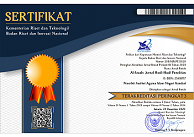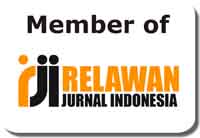HOW IS SOCIAL CAPITAL CONVERTED TO BE ECONOMIC CAPITAL? A CASE STUDY FROM PESANTREN’S SOCIO-ECONOMIC PROJECTS
Abstract
Keywords
Full Text:
PDFReferences
Abidien, Z., 2007. Mesin Uang Kaum Sarungan (the money machine of Sarungan Commmunity). Tempointeraktif. Tempo, Jakarta. Retrivied November 4, 2010 (http://majalah.tempointeraktif.com/id/arsip/2007/06/04/EB/mbm.20070604.EB124124.id.html)
Ahmad, M. 2006. Wawancara dengan KH Miftachul Akhyar (An Interview with KH. Miftachul Akhyar). Bulletin Sidogiri. Pondok Pesantren Sidogiri Pasuruan, Pasuruan.
Anggreni, P (2010). 5 Ribu BMT 5 Juta Usaha Mikro (5 Thousand BMT 5 Million Small Enterprises), Investor, XII (207) (2010), 72-73.
Babbie, E (2007). The Practice of Social Research; Eleventh Edition. Belmont: Thomson Wadsworth.
Budiwiranto, Bambang (2009). Pesantren and Participatory Development: The Case of the Pesantren Maslakul Huda of Kajen, Pati, Central Java. Journal of Indonesian Islam, 03 (02), 267-296.
Bourdieu, P (1986). The Forms of Capital. In: J. E. Richardson (Ed), Handbook of the theory of research for the sociology of education. New York: Greenword Press.
Bryman, A (1988). Quantity and Quality of Social Research. London: Unwin Hyman.
Bustami, A. L (2009). Kiai Politik Politik Kiai (The Political Kiai - The Politics of Kiai). Malang: Pustaka Bayan.
Coleman, J. S (1988). Social capital in the creation of human capital. The American Journal of Sociology, 94, 95-120.
Direktorat Pendidikan Keagamaan dan Pondok Pesantren (2001). Pondok Pesantren Agro Industri Di Indonesia. Jakarta: Direktorat Jenderal Kelembagaan Agama Islam. Departemen Agama Republik Indonesia.
Direktorat Jenderal Pendidikan Islam (2012). Analisis Dan Interpretasi Data Pada Pondok Pesantren, Madrasah Diniyah (Madin), Taman Pendidikan Qur (TPQ), Tahun Pelajaran 2011-2012. Jakarta: Kementerian Agama RI.
Dhofier, Z (1999 [1982]). The Pesantren Tradition: the Role of Kyai in the Maintenance of Traditional Islam in Java. Arizona: Arizona State University.
Husnan, U. 2006. Libur Ramadlan, ISS Adakan Haul Masyayikh and Pesrom. Buletin Sidogiri. Pondok Pesantren Sidogiri Pasuruan, Pasuruan.
Narayan, D. & Woolcock, M (2000). Social capital: implications for development theory, research, and policy. World Bank Research Observer, World Bank.
www.publicpolicy.umb.edu/~pubpol/.../Woolkock-Week11_001.pdf
Nurhasim, A. and Nur Khalik Ridwan (2004). Demoralisasi Khittah NU Dan Pembaruan. Yogyakarta: Pustaka Tokoh Bangsa.
Portes, A (1998). Social capital: Its origins and applications in modern sociology. Annual Review of Sociology 24 (1998).
Sakai, M (2008). Community development through Islamic microfinance: Serving the financial needs of the poor in a viable way. In Expressing Islam: religious life and politics in Indonesia. Fealy, G. & White, S., Institute of Southeast Asian Studies, Singapore.
Sakai, M. & Marijan, K (2008). Harnessing Islamic Microfinance. Australia Indonesia Governance Research Partnership, Crawford School of Economics and Government, ANU College of Asia and the Pacific, The Australian National University, Canberra. http://www.aigrp.anu.edu.au/publications/briefs.php
Sidogiri, P. P. P (2009). Laporan Tahunan Pengurus Pondok Pesantren Sidogiri (Annual Report of the Caretaker of Pondok Pesantren Sidogiri). Pasuruan: Pondok Pesantren Sidogiri Pasuruan.
van Bruinessen, Martin and Farid Wajidi (2006). Syu'Un Ijtima'Iyah and the Kiai Rakyat: Traditionalist Islam, Civil Society and Social Concerns. In: Nordholt, H.S. Indonesian Transitions. Yogyakarta: Pustaka Pelajar.
Yasin, N. H. (2007). Urusan GT & Dai: Kaderisasi Penerus Misi Nabi (Teacher Internship and Preacher: Generating Cadres for Sustaining the Prophet Missions). Ijtihad. Pondok Pesantren Sidogiri, Pasuruan.
Yasir, A. (2008). KHS Abdullah Schal, Ulama Kharismatik (KHS Abdullah Schal, a charismatic priest). Buletin Sidogiri. Pasuruan: Pondok Pesantren Sidogiri.
DOI: http://dx.doi.org/10.31332/ai.v14i1.1240
Copyright (c) 2019 Al-Izzah: Jurnal Hasil-Hasil Penelitian

This work is licensed under a Creative Commons Attribution-NonCommercial-ShareAlike 4.0 International License.










